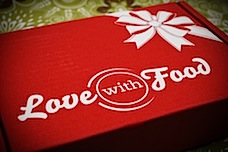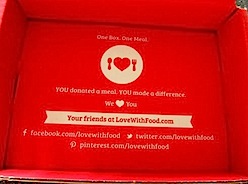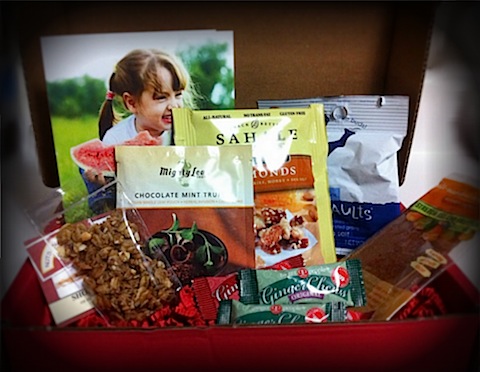Every boost economy has layers of value networks– networks through which different kinds of value flow.
When you imagine these nets of value stacked one on top of the other, connecting all the participants in the network on multiple dimensions, you see why we call it “thick value“.
While there’s no need to identity each layer of value by name, often a particular layer of value sets a given boost economy apart. This layer clarifies the economy’s strategic advantage and attracts participants who want to involve themselves in a community organized around that value.
 Layers of Value at LoveWithFood
Layers of Value at LoveWithFood
The power of a specific layer of value is demonstrated in the boost economy centered by LoveWithFood, a business founded by Aihui Ong. I met Aihui at BlogHer this summer and was excited to discover how LoveWithFood was generating its own lower-case e-conomy with a value layer that drew in a special subset of food enthusiasts.
On the surface, LoveWithFood looks like a typical “subscription box” business. LoveWithFood recruits unique, small-scale, and/or startup gourmet food manufacturers to supply samples of their products, curates these products into monthly collections, and mails these boxes to subscribers.
- Subscribers get actual samples to try new foods, recipes to incorporate these items to their menus, and discounts on full-size items.
- Food manufacturers get food enthusiasts to try their product and share feedback.
- LoveWithFood gets revenue from the subscribers and feature fees from the manufacturers, profits from the sale of full-size goods on their site, and market insights drawn from data about the taste preferences and purchase patterns of their subscribers.
Functionally, LoveWithFood is a typical multi-party platform, where the hub organization builds its business by linking sets of users with each other. The users get a boost through the initial link, and then can build their own business by following up on these links.
The Charity Layer
FoodWithLove, its subscribers, and its food suppliers all participate in a network of charitable value/contributions, what we might call the Charity layer.
With each box of samples that the subscriber pays for, LWF contributes to a food bank to feed hungry children. And, when subscribers purchase a food supplier’s full-size items from the LWF ecommerce site, LoveWith Food makes a donation to a food bank of that supplier’s choosing, in the name of that supplier. This way, every purchase leads to a contribution, with each of the network’s participants having some involvement in generating that contribution. The food banks that receive contributions from LoveWithFood customers and food merchants are able to serve healthy meals to more children, helping those children feel nourished and cared about.
This kind of ‘buy one, give one’ model is not unique — many other organizations like Toms Shoes and the Rootz ecommerce site use this model to link values to a purchase. Nor is the idea of a charitable mechanism unique — initiatives from corporate philanthropy to social entrepreneurship aim to link doing good to doing well with your business.

However, when the charity layer has a strong, identity-based link between the charity and the economy’s members, it can create other layers of value on top of the material flow of money and goods, because a shared value or characteristic flows among the economy’s members. Then, the ‘do good’ element of a charity layer spins off a network-specific ‘feel good’ element.
For LoveWithFood, the meaning of that ‘feel good’ element is its ‘special sauce’.
The “Love Layer” makes this boost economy special
What distinguishes LoveWithFood from other gourmet food subscription boxes is its “Love layer”.
“Love” is not just the first word in LoveWithFood’s business name. It’s also the emotional value that Aihui Ong wants to have flow through her business’s boost economy. As Aihui explains, food merchants and food enthusiasts generally share the belief that cooking and sharing food is an act of love and caring. So ‘food’ and ‘love’ are commonly connected, and loving through food is a shared passion.
Aihui believes that we share love when we prepare delicious and healthy food for others. For LoveWithFood’s subscribers, their cooking is where the additional layer of value begins. Her subscribers get a regular “boost” of new food ideas and recipes to incorporate into their cooking/loving, which they can use to build their capacity to ‘love with food’. The boost of love flows across the relationship between LoveWithFood and the subscriber, and from the subscriber out to her or his personal network.
The value also flows in a different direction, between the subscriber and the food merchant and then out to LoveWithFood’s network of charities and their clients. The love layer creates the opportunity for food enthusiasts and the food merchants to interact with each other, affirming and increasing their experience that food is love.
Not Every Member Participates in Each Layer of Boost Economy Value

Aihui notes that not every party involved in LoveWithFood’s boost economy are directly motivated by the “love layer”, and that’s okay.
LoveWithFood’s investors don’t need to think of themselves as participating actively in this value layer. Aihui doesn’t even insist that her investors be deliberately “mission-aligned.” However, because the charity and love layers are hardwired into Aihui’s business model, investors have to agree with the charitable contribution concept, mechanism, and cost.
Thick Value Includes Love Layers
When I talked with Aihui about the ideas that prompted her business, she told me that she didn’t think her business’s story and motivation was all that unique. The desire to share love by sharing food is universal, right?
That’s the beauty of this business boost economy model.
The mechanics of curating, sharing, sampling, and selling food products are built into this business, and so are the channels and mechanisms for an additional layer of value.
LoveWithFood’s boost economy is designed for reminding, nudging, helping, showing, and enabling us — subscribers, merchants, LoveWithFood employees, charitable organizations, and clients — to express LoveWithFood.
The ability to express this love is the ‘boost‘ that allows us- if we choose – to build our capacity to LoveWithFood.
See also:
Investigating The Boost Economy
Is there a Business Model behind that Values Statement?
Don’t Tell Esty That Authenticity Is Getting “Old” — The Social Dynamic Between Crafters and Buyers is Timeless
Make Distinctiveness Matter by Linking It To Organizational Purpose
Love with Food Subscription Box, NotExactlyBento lunch blog
Images from Not Exactly Bento.com and LoveWithFood
 I am an organizational consultant, change advocate, and organizational identity/reputation scholar with a PhD in leadership & organizations. I research, write about, and consult with organizations on the relationships between organizational identity, actions, and purpose. I teach Technology Management, part-time, at Stevens Institute of Technology.
My current research focuses on how social technologies in the workplace can drive organizational change, generate meaning, and catalyze purpose. See the
I am an organizational consultant, change advocate, and organizational identity/reputation scholar with a PhD in leadership & organizations. I research, write about, and consult with organizations on the relationships between organizational identity, actions, and purpose. I teach Technology Management, part-time, at Stevens Institute of Technology.
My current research focuses on how social technologies in the workplace can drive organizational change, generate meaning, and catalyze purpose. See the 
Comments on this entry are closed.